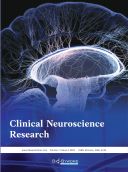Effect of Tirofiban Combined with Neurointerventional Therapy on Neurological Function of Patients with Acute Cerebral Infarction
Abstract
Objective: To analyze the effect of tirofiban combined with neurointerventional therapy on neurological function of patients with acute cerebral infarction. Methods: 70 patients with acute cerebral infarction admitted between January 2022 and January 2023 were selected as research objects, and patients were divided into control group (neurological interventional therapy) and experimental group (tirofiban combined with neurointerventional therapy) according to the computerized grouping method. The treatment outcomes of both groups were compared. Results: The efficacy of the treatment in the experimental group was 94.9%, which was significantly higher that of the control group control group at 77.14% (P < 0.05). Before treatment, there was no difference in the National Institutes of Health Stroke Scale and Barthel Index between the control group and the experimental group (P < 0.05); after treatment, the NIHSS score of the experimental group was lower than that of the control group, and the BI score was higher than that of the control group (P < 0.05). Before treatment, there was no difference in the levels of high-sensitivity C-reactive protein (hs-CRP) and neuron-specific enolase (NSE) between the control group and the experimental group (P < 0.05); after treatment, the levels of hs-CRP and NSE in the experimental group were lower than those in the control group (P < 0.05). Before treatment, there was no difference in the levels of carbon monoxide (CO), endothelin (ET), nerve growth factor (NGF), and myelin basic protein (MBP) between the control group and the experimental group (P < 0.05); after treatment, the levels of CO and NGF in the experimental group were higher than those in the control group, and the levels of ET and MBP were lower than those in the control group, with statistical significance (P < 0.05). Conclusion: Tirofiban combined with neurointervention is effective in treating acute cerebral infarction. It can not only control the development of the disease, but also improve the patients’ neurological function and the quality of life.
References
Chen C, 2021, Effect of Stent Thrombectomy Interventional Therapy on Neurological Function in Patients with Acute Cerebral Infarction. Heilongjiang Medicine, 34(2): 396–398.
Sun L, Xu Z, Han R, et al., 2023, A Randomized Controlled Study of Argatroban and Tirofiban in the Treatment of Acute Progressive Cerebral Infarction Beyond the Thrombolytic Time Window. 21(5): 926–930.
Lu C, Lu C, Zhang L, et al., 2022, Safety and Feasibility Study of Tirofiban Application in Perioperative Period of Interventional Therapy for Ruptured Intracranial Saccular Aneurysm. Chinese Journal of Cerebrovascular Diseases, 19(8): 524–531.
Zhao Y, Zhang P, Li X, 2022, The Clinical Effect of DSA-Guided Neuro-Interventional Thrombectomy in the Treatment of Acute Cerebral Infarction and its Influence on Hemodynamics and Vascular Endothelial Function. Chinese Journal of Emergency Resuscitation and Disaster Medicine, 17(10): 1304–1307.
Gao C, Jiao J, Zhao Y, 2022, Effect of Mechanical Interventional Thrombectomy Combined with Recombinant Tissue Plasminogen Activator Thrombolytic Therapy on Serum Factor Levels and Neurological Function in Patients with Acute Cerebral Infarction. Shanxi Medical Journal, 51(16): 1819–1822.
Jia Z, Fan Y, Jia J, et al., 2022, The Effect of Endovascular Intervention Combined with Tongnao Decoction for Acute Cerebral Infarction. Journal of Molecular Diagnosis and Therapy, 14(8): 1403–1406.
Zhu B, 2022, Clinical Efficacy and Prognosis Quality of Neurointervention Combined with Alteplase in The Treatment of Acute Ischemic Stroke. International Journal of Biomedical Engineering, 45(5): 419–423.
Li L, Liu Z, Zhang W, et al., 2022, Prognosis Analysis of Interventional Therapy for Elderly Patients with Acute Cerebral Infarction Within 4.5 Hours of Onset. Journal of Cardiopulmonary Vascular Diseases, 41(8): 898–902.
Tang F, Li Y, 2022, Effect of Intravenous Thrombolysis Combined with Interventional Therapy on Serological Indicators and Vascular Recanalization in Patients with Acute Cerebral Infarction. Chinese and Foreign Medical Research, 20(6): 115–118.
Fu J, Yang H, Wang Y, et al., 2022, The Effect of Alteplase Combined with Low-Dose Tirofiban on Serum Cytokine NIHSS Scores in Patients with Acute Cerebral Infarction. Hebei Medicine, 28(6): 1041–1047.
Yan X, Wang R, Wang Z, et al., 2022, The Effect of Tirofiban + Double Antibody Therapy on Patients with Acute Cerebral Infarction in the Ultra-Thrombolytic Window and its Impact on NIHSS and mRS Scores. Systematic Medicine, 7(5): 103–106.
Zhang Y, Liu J, Guo Z, 2022, The Combined Application of Alteplase and Tirofiban in the Treatment of Acute Cerebral Infarction and its Effect on Neurological Function. Heilongjiang Medicine, 35(2): 327–329.
Zhang H, Song D, 2022, Clinical Efficacy of Quxie Tongluo Decoction Combined with Tirofiban in the Treatment of Acute Cerebral Infarction. Liaoning Journal of Traditional Chinese Medicine, 49(4): 113–116.
Ma D, Li W, Li C, 2022, Clinical study of Compound Brain Peptide Ganglioside Injection Combined with Tirofiban in the Treatment of Acute Cerebral Infarction. Modern Medicine and Clinic, 37(7): 1497–1501.
Zhu X, Zhu J, Han X, 2022, Effect of Tirofiban Bridging with Aspirin and Clopidogrel on Platelet Activation in Patients with Acute Cerebral Infarction Over a Time Window. Journal of Harbin Medical University, 56(4): 363–367.

